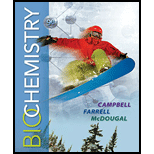
Concept explainers
RECALL Briefly summarize the steps in the electron transport chain from NADH to oxygen.
Interpretation:
The steps of the electron transport chain from
Concept introduction:
Electron transport chain is the series of electron transfer from electron donor to electron acceptor; it is a redox reaction.
It is the last component of aerobic respiration and is the only reaction that utilizes atmospheric oxygen.
Answer to Problem 1RE
Solution: Following are the steps of the electron transport chain from
Explanation of Solution
First the electrons from
Oxygen is the last electron acceptor that accepts electrons from cytochrome
Want to see more full solutions like this?
Chapter 20 Solutions
Biochemistry
- A protein biochemist attempted to determine the amino acid sequence of a decapeptide. The results from the trypsin, chymotrypsin, and cyanogen bromide treatments are shown: • Trypsin digestion gave two fragments with multiple residues (not in order): T1: Ala, Arg, Phe, Gly, Thr, Trp, Tyr • T2: Lys, Met, Val ⚫ Chymotrypsin digestion gave four fragments with multiple residues (not in order): • CT1: Ala, Phe ° • CT2: Thr, Trp 。 CT3: Lys, Met, Tyr, Val • CT4: Arg, Gly ⚫ Treatment with cyanogen bromide yielded a single amino acid, methionine, and a nonapeptide. What is a possible sequence of the decapeptide? Use three-letter abbreviations in your answer, and add a dash between each residue. sequence:arrow_forwardClassify each nucleotide or nucleoside by the type of base and sugar present in each image. HO. -CH₂ 0 NH₂ OH OH OH он NH Classify the molecule. Opurine, deoxyribose purine, ribose Opyrimidine, deoxyribose pyrimidine, ribose NH₂ Classify the molecule. purine, deoxyribose Opyrimidine, ribose Opurine, ribose pyrimidine, deoxyribose H₂C. ·CH₂ NH Classify the molecule. pyrimidine, ribose Opurine, deoxyribose O purine, ribose Opyrimidine, deoxyribose OHarrow_forwardWrite the complementary sequence for GACATC. Write the new sequence in the standard 5'-to-3' notation. 5'- -3'arrow_forward
- Suppose that you are given a mixture of proteins, whose properties are provided in the table. Isoelectric point (pl) Molecular weight (in kDa) Protein A 4.1 80 Protein B 9.0 81 Protein C 8.8 37 Protein D 3.9 172 Select one combination of techniques that can be used to isolate Protein B from Proteins A, C, and D. gel filtration chromatography and ultracentrifugation dialysis and ultracentrifugation dialysis and ion exchange chromatography ion exchange chromatography and gel filtration chromatographyarrow_forwardIn their famous experiment, Matthew Meselson and Franklin Stahl grew E. coli cells in a medium containing only the "heavy" isotope of nitrogen, 15N. These cells were then transferred to a medium with the "light" isotope of nitrogen, 14N. The results of the experiment supported the hypothesis of semiconservative replication, which was proposed by Watson and Crick. Heavy DNA (15N DNA), hybrid DNA, and light DNA (14N DNA) can be separated by centrifugation. If cells containing 15N DNA are transferred to a medium with only 14NH4Cl as a nitrogen source, what percentage of daughter molecules are composed of hybrid DNA after 3 generations? daughter molecules composed of hybrid DNA: Predict what percentage of daughter molecules would be composed of hybrid DNA if DNA exhibited conservative replication (i.e., if a daughter DNA molecule were composed of only newly synthesized DNA). daughter molecules composed of hybrid DNA: % %arrow_forwardWhich of these amino acids have R groups that have hydrogen-bonding potential? Ser Ile Glu Tyr Ala Thrarrow_forward
- Select the true statements about SDS-PAGE, a method of separating proteins. Assume that SDS-PAGE is performed under reducing conditions. Proteins are visualized using a dye that binds to the gel matrix, but not to proteins. Protein-SDS complexes have similar mass to charge ratios; therefore, separation is by size. Proteins are separated in a polyacrylamide gel matrix. Protein-SDS complexes migrate toward the negative electrode. Smaller proteins migrate faster through the polyacrylamide gel. Sodium dodecyl sulfate binds proteins, resulting in SDS-protein complexes that are similar in size.arrow_forwardClassify each feature as charactistic of DNA polymerase or RNA polymerase. DNA polymerase RNA polymerase Answer Bank uses deoxyribonucleoside triphosphates does not need a primer needs a primer uses ribonucleoside triphosphates exhibits semiconservative replicationarrow_forwardIdentify the components of replication, transcription, and translation processes. Replication Transcription Answer Bank ribonucleoside triphosphate ribosomal RNA promoter ribosome primer deoxynucleoside triphosphate RNA polymerase DNA polymerase transfer RNA Translationarrow_forward
- Classify each term and description based on whether it is associated with transfer RNA (tRNA), messenger RNA (mRNA), or ribosomal RNA (rRNA). tRNA mRNA Answer Bank rRNA product of transcription codon anticodon transports amino acids combines with protein to form ribosomesarrow_forwardThe results of a separation using two-dimension gel electrophoresis are shown here. Which protein or proteins have the highest pl value? a b and c d and e Which protein has the highest molecular weight? a C e isoelectric focusing electrophoresis pH 5 b pH 9 d SDS PAGE electrophoresisarrow_forwardCH3 HHO | | || CH₂OH | www.N-C-C-N-C-C-N-C-Cww I HHO H | | || HHO Determine which amino acids are present in the peptide. serine leucine alanine glycine threoninearrow_forward
 BiochemistryBiochemistryISBN:9781305961135Author:Mary K. Campbell, Shawn O. Farrell, Owen M. McDougalPublisher:Cengage Learning
BiochemistryBiochemistryISBN:9781305961135Author:Mary K. Campbell, Shawn O. Farrell, Owen M. McDougalPublisher:Cengage Learning
